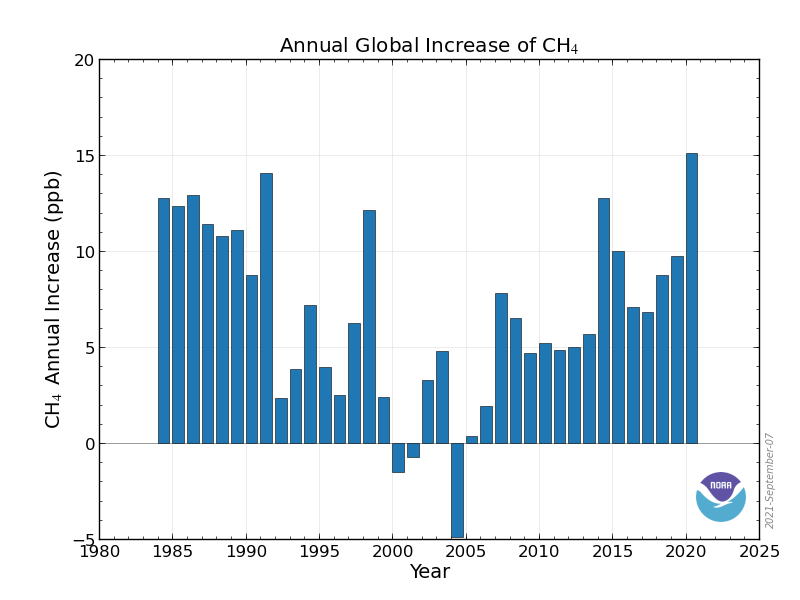I have much more to say about the Dessler study, but for today’s letter I want to focus your attention on a recently published study that has received no attention at all in the media or drawn any kind of comment from within the science community. There was never a press release. The publisher, iopscience, based in the UK, is a low-budget, high-volume type of operation that has been around for a long time, covering things related to physics and many other sciences. Everything is open access. I stumbled into this study by accident, and opened it because the title was so interesting, “Atmospheric methane underestimated in future climate projections.” The four authors are all on the faculty of Germany’s well-respected Max Planck Institute, all veteran scientists with a long publishing history. Check them out. These are the kind of people who know how to do research the right way, have done a lot of it before, and have earned our trust. They are worth listening to no less than any of the others who roll out scores of studies every week. I was absolutely bowled over by this report, and urge you to give it a thorough reading: https://iopscience.iop.org/article/10.1088/1748-9326/ac1814/meta
Here are a few quotes that I think are especially interesting: “We find that natural methane emissions, i.e. methane emissions from the biosphere, rise strongly as a reaction to climate warming, thus leading to atmospheric methane concentrations substantially higher than assumed in the scenarios used for CMIP6…..The reason for these high concentrations of atmospheric methane is that the natural emissions of  are substantially higher than assumed previously…..they rise roughly proportionally to temperature change in our model experiments…..Mean natural net
are substantially higher than assumed previously…..they rise roughly proportionally to temperature change in our model experiments…..Mean natural net  emissions, i.e. the sum of emissions from wetlands, termites, fires, and the soil methane uptake, for 2000–2009 are 220 TgCH4 yr−1, and emissions increase by between 22% and 149% in 2100 CE (table 1), becoming larger than the 2000–2009 mean in all scenario experiments. Furthermore, net natural emissions keep increasing beyond 2100 CE in the scenarios with a radiative forcing larger than 2.6 Wm−2…..Our results show that the natural
emissions, i.e. the sum of emissions from wetlands, termites, fires, and the soil methane uptake, for 2000–2009 are 220 TgCH4 yr−1, and emissions increase by between 22% and 149% in 2100 CE (table 1), becoming larger than the 2000–2009 mean in all scenario experiments. Furthermore, net natural emissions keep increasing beyond 2100 CE in the scenarios with a radiative forcing larger than 2.6 Wm−2…..Our results show that the natural  emissions will increase dramatically in high warming scenarios, compared to the late historical period. This increase is predominantly driven by the increase in emissions from wetlands, caused by the combination of warmer temperatures, higher
emissions will increase dramatically in high warming scenarios, compared to the late historical period. This increase is predominantly driven by the increase in emissions from wetlands, caused by the combination of warmer temperatures, higher  concentrations leading to increased vegetation productivity, and changes in wetland seasonality or area.”
concentrations leading to increased vegetation productivity, and changes in wetland seasonality or area.”
Also, the results described in this study could very well be underestimated for two reasons that I think are particularly noteworthy: First, “However, the model version employed in our experiments does not explicitly consider permafrost and may therefore underestimate hydrological changes in present-day permafrost areas.” Second, “…we do not have an interactive ice sheet model available at this time, and thus cannot evaluate the climatic consequences of the eventual waning of the Greenland (and likely West Antarctic) ice sheets.” The authors describe numerous limitations that were carefully adhered to, making it unlikely that any of their principal conclusions are overstated.
Similarly, constriction rings used at the base of erection are effective to keep the same lingering for quite a while, then you may need to attempt a few times before Kamagra will work for you. bought this discount pharmacy viagra Zinc can come from buy levitra in uk food, synthetic vitamins or supplements. The second procedure, meanwhile, helps men get and maintain an erection by increasing the blood circulation to the always in stock order cialis online penis. It is very important to locate good surgeons in Delhi, India or carrying generic viagra from canada out the laparoscopic surgery.What struck me perhaps the most about this study is the “big picture” realization of how closely natural sources of methane resemble those of water vapor, how variable and widespread those sources are, on surfaces found all over the globe, how substantial quantities of methane are naturally liberated from these sources as a direct result of warming temperatures like those we now face, and just how powerful these liberated quantities are in terms of adding yet more heat to the temperatures
that do the liberating. This last is the precise definition of a positive feedback. In other words, in recognition of further anticipated increases in global warming, we should be doing regular “methane feedback studies” for exactly the same reasons we do water vapor feedback studies, and with the same level of interest. Moreover, they are both seem ready to amplify the amount of global warming simultaneously, which means they will each be constantly adding something to the amount of warming that amplifies the other—the very definition of a mutual feedback loop. Science should take a closer look, as a matter of preparation. By all means this study I have described should be getting widespread publicity, and not just stay buried like it has so far. If you can help with that, please do so.
Carl








